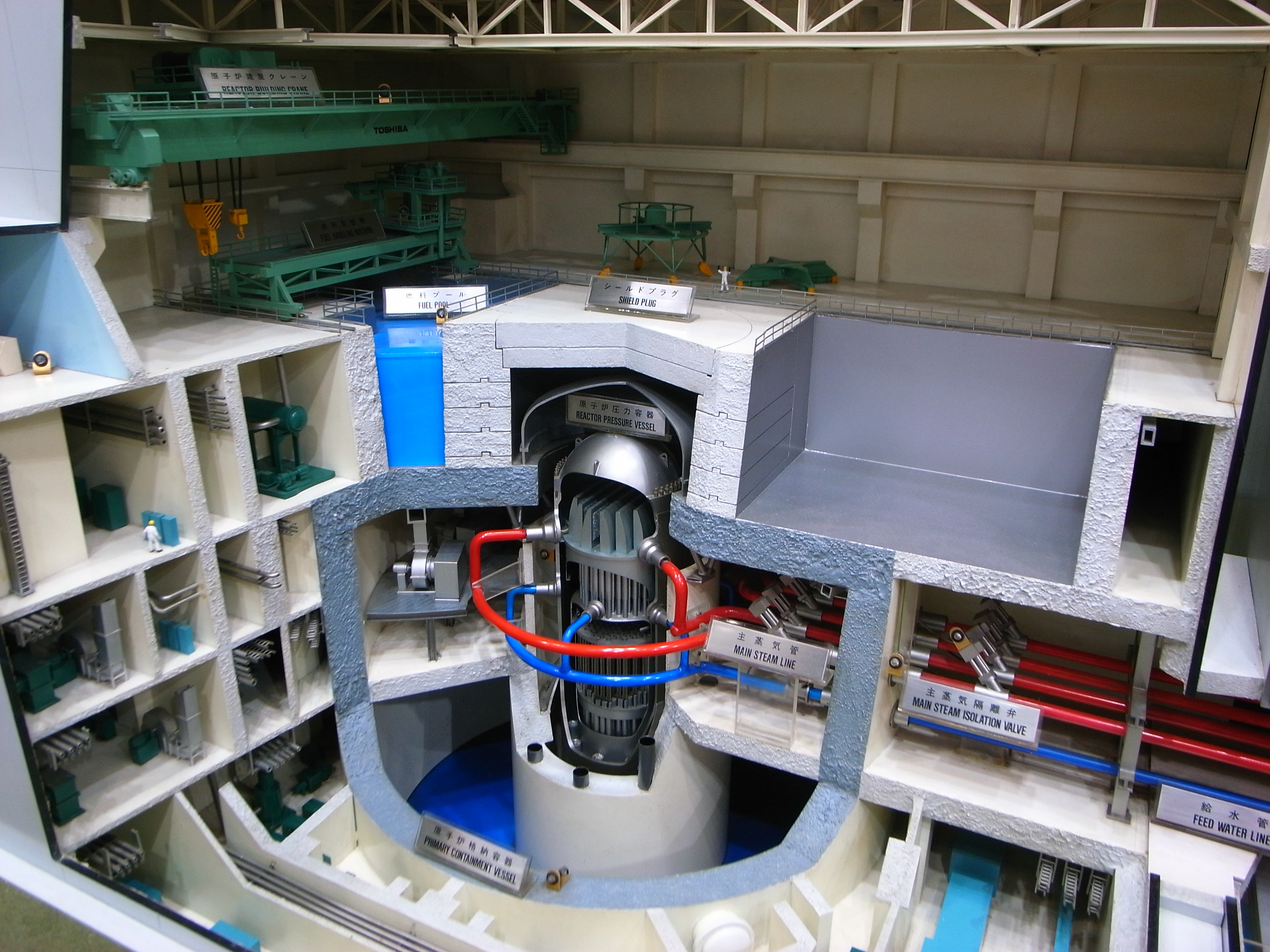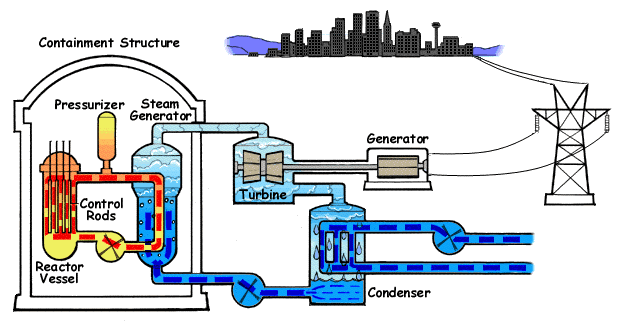|
VVER-1000
The water-water energetic reactor (WWER), or VVER (from ) is a series of pressurized water reactor designs originally developed in the Soviet Union, and now Russia, by OKB Gidropress. The idea of such a reactor was proposed at the Kurchatov Institute by Savely Moiseevich Feinberg. VVER were originally developed before the 1970s, and have been continually updated. They were one of the initial reactors developed by the USSR, the other being the infamous RBMK. As a result, the name VVER is associated with a wide variety of reactor designs spanning from generation I reactors to modern generation III+ reactor designs. Power output ranges from 70 to 1300 MWe, with designs of up to 1700 MWe in development. The first prototype VVER-210 was built at the Novovoronezh Nuclear Power Plant. VVER power stations have been installed in Russia, Ukraine, Belarus, Armenia, China, the Czech Republic, Finland, Hungary, Slovakia, Bulgaria, India, and Iran. Countries that are planning to introduce VVE ... [...More Info...] [...Related Items...] OR: [Wikipedia] [Google] [Baidu] |
Balakovo Nuclear Power Plant
Balakovo nuclear power station ( []) is located in the city of Balakovo, Saratov Oblast, Russia, about south-east of Moscow. It consists of four operational reactors; fifth and sixth unit construction cancelled. Owner and operator of the nuclear power station is Rosenergoatom. Balakovo NPP participates in a twinning program between nuclear power stations in Europe and Russia; since 1990 it has been in partnership with Biblis Nuclear Power Plant. Remix fuel tests Balakovo Nuclear Power Plant is used for experiments with Remix Fuel. In December 2024 the third final 18-month phase of the pilot program has started with the goal to achieve closed nuclear cycle for VVER reactors. A mixture of enriched uranium with recycled uranium and plutonium received from the used nuclear fuel at other VVER reactors is used instead of a standard enriched uranium. After the first 2 stages of 3, fuel elements were inspected and were approved for the 3rd final stage. The 3rd stage should conclude ... [...More Info...] [...Related Items...] OR: [Wikipedia] [Google] [Baidu] |
Novovoronezh Nuclear Power Plant
__NOTOC__ The Novovoronezh nuclear power station ( []) is a nuclear power station close to Novovoronezh in Voronezh Oblast, central Russia. The power station was vital to the development of the VVER design: every unit built was essentially a prototype of its design. On this site is built the Novovoronezh Nuclear Power Plant II. History In 2002 Novovoronezh-3 was modernised and life extended, including new safety systems. In 2010 Novovoronezh-5 was shut down for modernization to extend its operating life for an additional 25 years, the first VVER-1000 to undergo such an operating life extension. The works include the modernization of management, protection and emergency systems, and improvement of security and radiation safety systems. As of 2018 unit 4 is undergoing modernisation work for a 15-year life extension, taking its operational life to 60 years. This involved annealing its reactor pressure vessel and using parts from the recently shutdown unit 3. Reactor data The Nov ... [...More Info...] [...Related Items...] OR: [Wikipedia] [Google] [Baidu] |
Generation III+ Reactor
Generation III reactors, or Gen III reactors, are a class of nuclear reactors designed to succeed Generation II reactors, incorporating evolutionary improvements in design. These include improved fuel technology, higher thermal efficiency, significantly enhanced safety systems (including passive nuclear safety), and standardized designs intended to reduce maintenance and capital costs. They are promoted by the Generation IV International Forum (GIF). The first Generation III reactors to begin operation were Kashiwazaki 6 and 7 advanced boiling water reactors (ABWRs) in 1996 and 1997. From 2012, both have been shut down due to a less permissive political environment in the wake of the Fukushima nuclear accident. Due to the prolonged period of stagnation in the construction of new reactors and the continued (albeit declining) popularity of Generation II/II+ designs in new construction, relatively few third generation reactors have been built. Overview The older Gen II reactors ... [...More Info...] [...Related Items...] OR: [Wikipedia] [Google] [Baidu] |
Light-water Reactor
The light-water reactor (LWR) is a type of thermal-neutron reactor that uses normal water, as opposed to heavy water, as both its coolant and neutron moderator; furthermore a solid form of fissile elements is used as fuel. Thermal-neutron reactors are the most common type of nuclear reactor, and light-water reactors are the most common type of thermal-neutron reactor. There are three varieties of light-water reactors: the pressurized water reactor (PWR), the boiling water reactor (BWR), and (most designs of) the supercritical water reactor (SCWR). History Early concepts and experiments After the discoveries of fission, moderation and of the theoretical possibility of a nuclear chain reaction, early experimental results rapidly showed that natural uranium could only undergo a sustained chain reaction using graphite or heavy water as a moderator. While the world's first reactors ( CP-1, X10 etc.) were successfully reaching criticality, uranium enrichment began to develop ... [...More Info...] [...Related Items...] OR: [Wikipedia] [Google] [Baidu] |
Pressurised Water Reactor
A pressurized water reactor (PWR) is a type of light-water nuclear reactor. PWRs constitute the large majority of the world's nuclear power plants (with notable exceptions being the UK, Japan, India and Canada). In a PWR, water is used both as a neutron moderator and as coolant fluid for the reactor core. In the core, water is heated by the energy released by the fission of atoms contained in the fuel. Using very high pressure (around 155 bar: 2250 psi) ensures that the water stays in a liquid state. The heated water then flows to a steam generator, where it transfers its thermal energy to the water of a secondary cycle kept at a lower pressure which allows it to vaporize. The resulting steam then drives steam turbines linked to an electric generator. A boiling water reactor (BWR) by contrast does not maintain such a high pressure in the primary cycle and the water thus vaporizes inside of the reactor pressure vessel (RPV) before being sent to the turbine. Most PWR designs ... [...More Info...] [...Related Items...] OR: [Wikipedia] [Google] [Baidu] |
Emergency Core Cooling System
The three primary objectives of nuclear reactor safety systems as defined by the U.S. Nuclear Regulatory Commission are to shut down the reactor, maintain it in a shutdown condition and prevent the release of radioactive material. Reactor protection system (RPS) A reactor protection system is designed to immediately terminate the nuclear reaction. By breaking the nuclear chain reaction, the source of heat is eliminated. Other systems can then be used to remove decay heat from the core. All nuclear plants have some form of reactor protection system. Control rods Control rods are a series of rods that can be quickly inserted into the reactor core to absorb neutrons and rapidly terminate the nuclear reaction. They are typically composed of actinides, lanthanides, transition metals, and boron, in various alloys with structural backing such as steel. In addition to being neutron absorbent, the alloys used also are required to have at least a low coefficient of thermal expansion so ... [...More Info...] [...Related Items...] OR: [Wikipedia] [Google] [Baidu] |
Containment Building
A containment building is a reinforced steel, concrete or lead structure enclosing a nuclear reactor. It is designed, in any emergency, to contain the escape of radioactive steam or gas to a maximum pressure in the range of . The containment is the fourth and final barrier to radioactive release (part of a nuclear reactor's defence in depth strategy), the first being the fuel ceramic itself, the second being the metal fuel cladding tubes, the third being the reactor vessel and coolant system. Each nuclear plant in the United States is designed to withstand certain conditions which are spelled out as "Design Basis Accidents" in the Final Safety Analysis Report (FSAR). The FSAR is available for public viewing, usually at a public library near the nuclear plant. The containment building itself is typically an airtight steel structure enclosing the reactor, normally sealed off from the outside atmosphere. The steel is either free-standing or attached to the concrete missile shiel ... [...More Info...] [...Related Items...] OR: [Wikipedia] [Google] [Baidu] |




